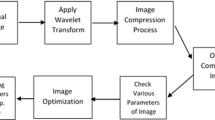Summary
This work deals with the optimum compression rates that can be obtained by means of two DCT coding techniques in order to preserve the radiograms “diagnostic information”.
The results of a quality analysis of compressed digitized radiographics images of incomplete fractures are presented. A consistent meaningful set of radiograms was coded by Bordoni Foundation in Rome and quality tested by a team of radiologists working at the Radiology Department of the University of Pisa.
ROC curves [7] were obtained from the results of the observations of trained radiologists who analyzed the compressed images without any previous knowledge of the algorithms used for coding.
Access this chapter
Tax calculation will be finalised at checkout
Purchases are for personal use only
Preview
Unable to display preview. Download preview PDF.
Similar content being viewed by others
References
R. J. Clarke, “Transform Coding of Images”, Academic Press, 1985.
ISO/IEC IS 10918–1 — CCITT Rec. T.81: Digital compression and coding of continuous-tone still images — Part 1: Requirements and guidelines, 1992.
K. N. Ngan, R. J. Clarke, “Low-pass filtering in the cosine transform domain”, Proceedings of ICC 1990, pp. 31.7.1–5 Seattle.
K. R. Rao, P. Yip, “Discrete Cosine Transform — Algorithms, Advantages, Applications”, Academic Press, San Diego, 1990.
G. R. Kuduvalli, R. M. Rangayyan, “Performance Analysis of Reversible Compression Techniques for High-Resolution Digital Teleradiology”, IEEE Transaction on Medical Imaging, vol. 11, No.3, pp.430–445, September 1992.
M. Ibrahim Sezan, Kwok-Leung Yip, Scott J. Daly, “Uniform Perceptual Quantization: Applications to Digital Radiography”, IEEE Trans, on Systems, Man, and Cybernetics, vol. SMC-17, No.4, pp. 622–634, July/August 1987.
Gur D, Rockette HE, Good WF, Slasky BS, Cooperstein LA, Straub WH, Obuchowski NA, Metz CE. Effect of observer instruction on ROC study of chest images. Investigative Radiology: 25, 230–234, 1990.
Author information
Authors and Affiliations
Editor information
Editors and Affiliations
Rights and permissions
Copyright information
© 1993 Springer-Verlag Berlin Heidelberg
About this paper
Cite this paper
Trippi, D. et al. (1993). Assessment of DCT-Based Method for X-Ray Image Compression. In: Lemke, H.U., Inamura, K., Jaffe, C.C., Felix, R. (eds) Computer Assisted Radiology / Computergestützte Radiologie. Springer, Berlin, Heidelberg. https://doi.org/10.1007/978-3-642-49351-5_17
Download citation
DOI: https://doi.org/10.1007/978-3-642-49351-5_17
Publisher Name: Springer, Berlin, Heidelberg
Print ISBN: 978-3-642-49353-9
Online ISBN: 978-3-642-49351-5
eBook Packages: Springer Book Archive




